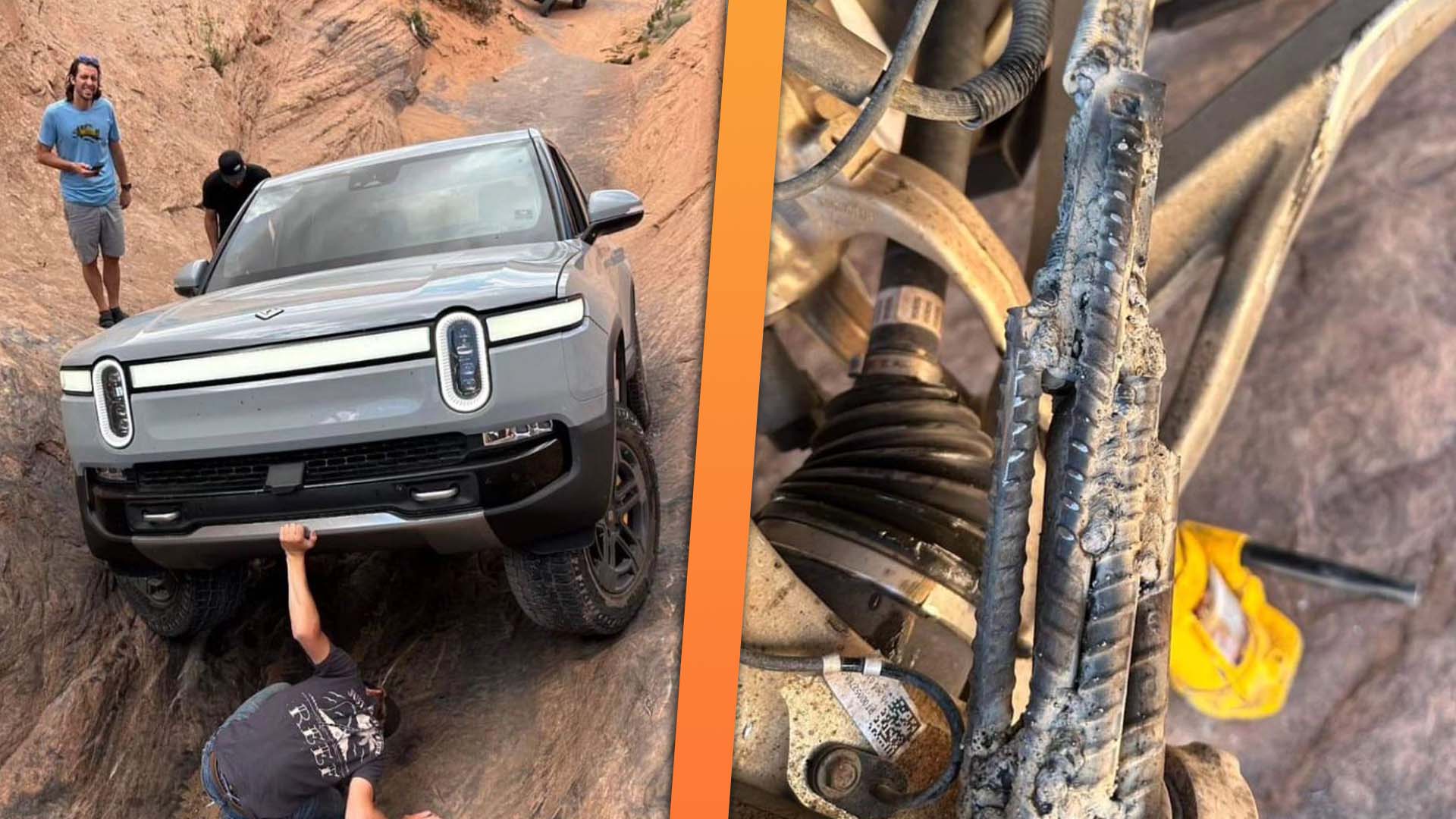

Off-road trucks are bound to break at some point—it’s a fact of life. When you’re pushing parts to their limits, no matter if it’s a beater Jeep or an $80,000 electric adventure pickup, it’s gonna happen. That was proven by this Rivian R1T that got busted up big time on Hell’s Gate in Moab last week, and even though it’s a high-dollar rig, a zero-budget solution was what it took to get unstuck.
The R1T was rescued by David Hellman, owner of Xtreme 4×4 Tours and Moab Scenic Adventures. He doesn’t claim to be a recovery pro, but he just so happens to own a Chevy K30 4×4 wrecker that gets around the slick rock just fine. Hellman tells me he received a call to retrieve the Rivian after seeing it on the trails earlier that day.
“I guess he was going up Hell’s Gate and when he went to back up, it snapped the tie rod in half—like, on the inner tie rod at the threaded area, maybe four inches from the outer tie rod,” Hellman told me on the phone. “I went out there with my welder and I just grabbed a couple of pieces of flat metal, some skinny stuff. I didn’t know what I was getting into because they didn’t send me any photos.”
“An old Chevy truck, you can weld on those but I know there are certain vehicles that if you weld on them, it can screw with the computer system,” Hellman continued. “I’m looking at an EV going, ‘This entire vehicle is a computer system.’ I asked [the owner] if I could weld on it and he was like, ‘I don’t know.’ I didn’t know either but there was only one way to get it out.”


The initial fix worked for a little while, though when the R1T neared the top of the obstacle, Hellman says the outer tie rod was sheered in half.
“I lifted it up and had one or two little pieces of metal left. I started welding on it and realized I was using .035mm wire and I had an .030 tip on it,” Hellman said. “The welder wasn’t stoked, it wasn’t wanting to push the wire out, so we called it a night and we left the Rivian parked at the top of Hell’s Gate, over by the entrance.”
This is where it got interesting. Hellman searched his shop for something more suitable to patch the Rivian up, and wouldn’t you know it, he found “a foot and a half or two feet of rebar just sitting there.” He grabbed that and cut it into four pieces, knowing the tie rod was already compromised so it wouldn’t hurt anything.

Photos of the trail fix have been shared far and wide at this point. It’s not every day you see a repair this quick and oh-so-temporary on an EV that’s still virtually new. Then again, not everyone takes their battery-powered pickup on Moab’s famously challenging trails.
“I welded the crap out of those three bars and we were all stoked, ready to go,” Hellman said. “He was following me out and I was like, ‘Dude, let me put a strap on you so you don’t have to throttle this thing hard and bend something else.’
“I don’t know if you know Hell’s Revenge very well but there’s a part going out where you get back onto the slick rock and it’s kind of a steep hill with a hard right-hand turn at the top. We call it the Corkscrew. He went to the top of that, got on the throttle—it’s somewhere you have to throttle it—and the factory tie rod bent right at the very end of the rebar where I quit welding.”

Hellman says it bent at a 90-degree angle with both front tires turned all wonky. The only way forward was to get an angle grinder and cut the tie rod in half. At this point, Hellman was out of rebar so he cut the head off a Grade 8 bolt, that way he had a straight piece of metal to connect everything.
Multiple reports of Rivians with broken tie rods are scattered across owner forums and social media. Several popped up last year, and Hellman says it’s because they’re brittle, especially for a truck that weighs nearly 7,200 pounds.
“I swear that the Rivian tie rod is just a stock Chevy IFS tie rod. They’re skinny and weak,” Hellman said. “So there may have been something in Moab that could’ve worked, but I wasn’t going to an auto parts store and just start buying tie rods. Being a recovery guy with a welder, I was just like, ‘Yeah, weld the crap out of it.'”
The R1T was eventually able to complete the trail under its own power, but it took a lot of work to get there. I reached out to the owner to find out what’s next but I haven’t heard back yet. Either way, you can bet it’ll be sidelined for at least a little while as it waits on replacement suspension parts.
Repairing electric vehicles yourself may not get any easier in the future, but for now, let this serve as a lesson. If you’re out in the desert, wheeling a high-powered, high-voltage truck like this R1T, the same old tricks that have worked for years could be the only way to limp it home in one piece.
Got a tip or question for the author? Contact them directly: caleb@thedrive.com